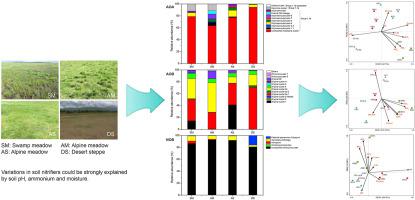European Journal of Soil Biology ( IF 4.2 ) Pub Date : 2021-04-21 , DOI: 10.1016/j.ejsobi.2021.103316 Xing-e Qi , Chen Wang , Tianjiao He , Fan Ding , Aorui Li , Xinfang Zhang , Lizhe An , Shijian Xu

|
Nitrification is a critical process of nitrogen (N) cycling performed by ammonia-oxidizing archaea (AOA) and bacteria (AOB), nitrite-oxidizing bacteria (NOB), and complete ammonia oxidation (comammox). However, the performance of these nitrifying groups in alpine grasslands has rarely been documented. This study investigated their abundance and community structure in four alpine grasslands on the Qinghai‒Tibetan Plateau with quantitative PCR and high-throughput sequencing. Potential ammonia oxidation (PAO) was measured and partitioned by inhibitor method. PAO was mainly dominated by AOA. PAO and potential nitrite oxidation (PNO) significantly decreased, while the apparent half-saturation constant (Km) had no significant change along a grassland degradation gradient. Phylogenetic analyses revealed that the predominant AOA, AOB, and NOB were Nitrososphaera, Nitrosospira, and Nitrospira lineages, respectively. Network analyses revealed that the alpine nitrifying co-occurrence network had a modular structure that was mainly shaped by taxonomic relatedness and environmental relationships, indicating different nitrifying species occupy disparate niches. Soil pH, ammonium, and moisture were the main drivers for variation in AOA, AOB, and NOB communities, respectively. Here, we provide evidence of niche differentiation in nitrifying communities with changes in grassland type. Moreover, these findings support a theoretical foundation for predicting the repercussions of grassland degradation on soil nitrifying communities in alpine ecosystems.
中文翻译:

青藏高原高寒草地类型的变化驱动硝化群落的生态位分化
硝化作用是由氨氧化古细菌(AOA)和细菌(AOB),亚硝酸盐氧化细菌(NOB)和完全氨氧化(comammox)进行的氮(N)循环的关键过程。然而,这些硝化基团在高寒草原上的表现鲜有记载。本研究利用定量PCR和高通量测序技术研究了青藏高原四个高山草原上它们的丰度和群落结构。测量了潜在的氨氧化(PAO)并通过抑制剂法进行了分配。PAO主要由AOA主导。PAO和潜在的亚硝酸盐氧化(PNO)显着降低,而表观半饱和常数(K m沿草地退化梯度没有明显变化。系统发育分析表明,主要的AOA,AOB和NOB为亚硝基球菌,亚硝基螺菌和亚硝基螺菌。宗族,分别。网络分析表明,高山硝化共生网络具有模块化结构,主要由生物分类相关性和环境关系决定,表明不同的硝化物种占据不同的生态位。土壤pH,铵和水分分别是AOA,AOB和NOB群落变化的主要驱动力。在这里,我们提供了随着草地类型的变化,硝化群落中生态位分化的证据。此外,这些发现为预测草地退化对高山生态系统中土壤硝化群落的影响提供了理论基础。



























 京公网安备 11010802027423号
京公网安备 11010802027423号